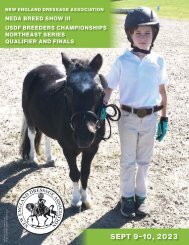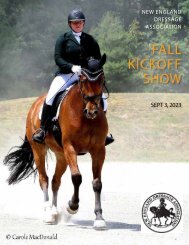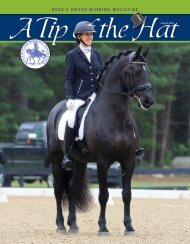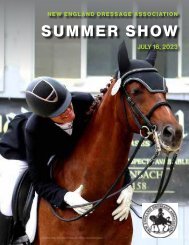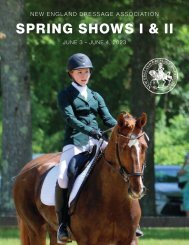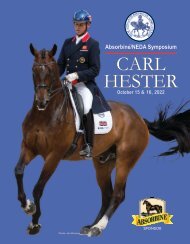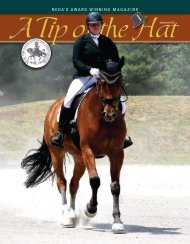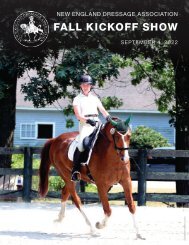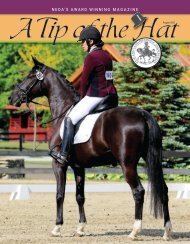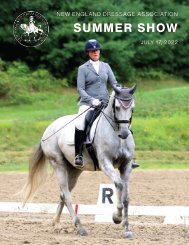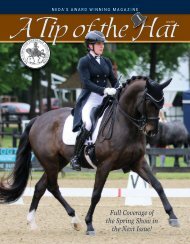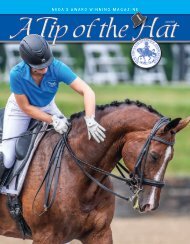NEDA A Tip of the Hat Nov-Dec 2020
New England Dressage Association's award winning newsletter.
New England Dressage Association's award winning newsletter.
Create successful ePaper yourself
Turn your PDF publications into a flip-book with our unique Google optimized e-Paper software.
N E D A’ S A W A R D W I N N I N G N E W S L E T T E R
ATip of the Hat
Nov/Dec 2020
PRESIDENT’S PAGE
A
s I write this, I am reminded of
Sally Swift’s Four Basics of
Centered Riding – Soft Eyes,
Breathe, Balance and Center.
Why? Because it is the day before the
federal election, the corona virus cases and
deaths are rising, the fires and hurricanes
are ravaging our country, and everyone’s
world feels out of kilter. I think the only good
thing that can be said of 2020 is that it is
nearly over! What to do when there is chaos
everywhere? Find a quiet place and focus.
When I took over as NEDA President one
year ago, I was nervous but excited. I still am
but for different reasons. I am nervous about
choices the Board has had to make, and excited
to be starting a new year with new
hope. The hope is that we can get back to
our regular schedule of competitions and education
events, following safety guidelines
and procedures. I hear the sentiment of
“enough already”, let’s move forward. As the
year comes to an end, I speak for the entire
NEDA Board when I wish all of you a safer,
saner, more satisfying 2021.
As there are 29 holidays observed by
seven of the world’s major religions between
November 1st and January 15th, I wish
everyone Happy Holidays!
Cheers
Iris
Iris
Nov/Dec 2020 NEDA.ORG TIP OF THE HAT 3
A Tip of the Hat
Contents:
3 President’s Page
5 Improve Your Seat with Dave Thind
9 NEDA Wins Big!
9 Wanted: Year End Awards Coordinator
Position
10 Extra! Extra! Amateur Photos Wanted
11 Ode to Zoomie
12 Feel the Rhythm, Feel the Rhyme
Get on Up, It’s Dressage Time! Part 2
14 NEDA Calendar 2020
15 Young Riders Receive Grants
16 Morsels of Horse Information
18 Youth Corner
19 Youth Corner: Chatting with
Tessa Holloran
20 Wanted: Nominations Manager Position
20 Educational Scholarships
21 NEDA Know-How Info
22 Stallion Paddock
A Tip of the Hat is a publication of The New England
Dressage Association, Inc., a non-profit, tax exempt
corporation.
MEMBERSHIP QUESTIONS
AND CHANGES OF ADDRESS
Please contact: Tammy Paparella
6 Pratt’s Junction Rd.
Sterling, MA 01564
978-422-2324
memberentry@neda.org
A TIP OF THE HAT ADVERTISING
Classified ads must be submitted to the Advertising
Editor via email in plain text (.txt) or word (.doc).
Display ads and photos may be submitted via email
to the Advertising Editor. Ads must be high resolution,
press ready PDFs with all images and fonts embedded
or high resolution TIF, JPG or EPS. MS Word doc templates
are available for your use at neda.org and can be
converted to PDFs.
All ads must be submitted to the Advertising Editor
with a check made out to NEDA.
Contact: Angela Prenosil,
413-627-2699 ▲tipads@neda.org
Follow us!
@NEDAdressage
#NEDAdressage
4 TIP OF THE HAT NEDA.ORG Nov/Dec 2020
NEDA 2020 OFFICERS
President:
Iris Berdrow
781-589-6422
president@neda.org
Vice President-Activities:
Kate O’Connor
508-612-6985
vpactivities@neda.org
Vice President-Services:
Jennifer Dillon
508-641-3121
vpservices@neda.org
Board Secretary:
Heather Stone
617-480-8077
secretary@neda.org
Treasurer:
Helen van der Voort
917-834-2635
treasurer@neda.org
COORDINATORS
and MANAGERS
EDUCATION COMMITTEE
Education Coordinator:
Sally Davenport
781-378-1881; 781-854-2547
education@neda.org
Judge Education:
Sally Davenport
781-378-1881; 781-854-2547
judgeed@neda.org
Symposium Organizer:
Beth Beukema
508-320-6549
fallsym@neda.org
COMPETITION COMMITTEE
Competitions Coordinator:
Beth Jenkins
508-655-6490; 508-733-3672
shows@neda.org
Spring Show:
Paul Cormier
508-995-5988; 508-847-2931
springshow@neda.org
Schooling Shows Manager:
Peter Chavonelle, Jr.
schoolingshows@neda.org
Sport Horse/Breed Shows:
Kathy Hickerson
603-673-4344; 603-557-4054
sporthorse@neda.org
Year-End Awards:
yea@neda.org
COORDINATORS and MANAGERS
SPONSORSHIP COMMITTEE
Sponsorship Coordinator:
Kari Cincotta
781-654-7694
sponsorship@neda.org
Sponsor Facilitator:
Open
sponsorfacilitator@neda.org
Sponsor Development:
Open
sponsordev@neda.org
MEMBERSHIP COMMITTEE
Membership Services Coordinator:
Dawn Mackenzie
518-657-1773
membership@neda.org
Nominations:
Open
volunteer@neda.org
Ombudsman:
Lainey Johnson
978-568-0523
ombudsman@neda.org
Member-at-Large:
Leslie de Grandmaison
603-759-4642
memberatlarge@neda.org
Kerstin Witaszek
413-695-0693
witaszekk@neda.org
PUBLIC RELATIONS
COMMITTEE
Public Relations Coordinator:
Krista Nordgren
207-749-6643
pr@neda.org
Communications/Social Media:
Krista Nordgren
207-749-6643
communications@neda.org
Photography:
Carole MacDonald
508-366-7886
photo@neda.org
Technology Coordinator:
technology@neda.org
NEWSLETTER STAFF
TIP Editor:
Angela Prenosil
413-627-2699
TipEditor@neda.org
Graphic Design:
June Evers
845-294-0656
jevers@warwick.net
TIP Advertising:
Angela Prenosil
413-627-2699
tipads@neda.org
USDF REGION 8
Cover: Drybrook's Annika's
Angel and Claire Piacentini
Fall Show 2019
Photo: Carole MacDonald
Region 8 Director:
Debra Reinhardt
region8dir@usdf.org
Youth Coordinator:
Bobbi Carleton
bobbicarleton@aol.com
ADDITIONAL CONTACTS
& OFF-BOARD ROLES
Membership Services:
Tammy Paparella
978-257-1374
region8dir@usdf.org
Fall Show Manager:
Sue McKeown
fallshow@neda.org
Fall Festival Volunteer
Recruitment:
Helen van der Voort
917-834-2635
fallvolunteer@neda.org
Summer Show Manager:
Paul Cormier
508-995-5988; 508-847-2931
springshow@neda.org
Northeast Region OPL:
Doreen Quintilliani
Jennifer Dillon
opl@neda.org
Advertising - Outbound:
advertising@neda.org
Scholarships:
Amy Bresky
978-270-3880
scholarships@neda.org
Partners in Education Tier 1:
Angela Prenosil
413-627-2699
edpartners1@neda.org
Partners in Education Tier 2 & 3:
Ann Smith
edpartners2@neda.org
Bookkeeper:
Carol Gordon
774-225-8878
bookkeeper@neda.org
Equine Affaire:
Karin Swanfeldt
ea@neda.org
Youth Liaison:
Sophia Chavonelle
youth@neda.org
NEDA Stallion Auction, Recruitment:
Mary Barrett
978-270-3338
stallionrecruit@neda.org
NEDA Stallion Auction:
Kathy Hickerson
603-673-4344; 603-557-4054
stallionauction@neda.org
The Salute, Editor:
Gail Wagner
salute@neda.org
The Salute, layout & design:
Cheri Bryant
bryantdesign@me.com
Webmaster:
Cheri Bryant
webmaster@neda.org
EDUCATION
This Winter,
Improve Your Seat from Home
using the Feldenkrais Method ®
BY DAVE THIND
A
lready ages ago, NEDA organized
Feldenkrais® based
training opportunities. In this article,
NEDA member Dave Thind shares his
passion for seat training using the
Feldenkrais Method ® .
As a rider, each and every day spent in the
saddle is an opportunity to learn and improve.
Almost every rider wishes to improve
their relationship with their horse. This can
be done both on and off the ground. Once
mounted, we do this by improving our seat
as well as soft but clear aids and communication.
By following classical principles and
listening to our horses for feedback, we
work towards glimpses of the right feeling.
These glimpses then turn into longer periods
and finally new habits are formed.
Ideally, we do all this in a biomechanically
sound way that meets the requirements of
modern competition standards.
In order to work towards this, we should be
willing to continuously improve our basics.
The most important foundation upon which
all other things are built upon in riding is
finding a position in the saddle which allows
for soft, balanced, and relaxed movement
in your horse.
“The most important part of training a horse
is training the rider’s position” stated
German Master Christoph Hess.
Riders at the highest levels remark that
each day they spend time working on their
seat. They understand how to evolve the
movement of their seat for the individual
movements of their horse. The seat should
be adjustable enough so that you can feel
and softly influence what your horse is
doing every step.
Photo: C.A. Hill Photo
ACHIEVING A SUPPLE SEAT
The horse’s center of gravity is not constant
and kinetic forces from the horse need to
move through the rider. The rider can learn
to filter this movement, but it has to go
somewhere! Therefore, a supple seat is
needed to allow a horse to move correctly
over its back, without blocking the horse.
Blocking the horse, albeit unintentionally,
can lead to training issues like not pushing
enough from behind, a dropped back, unsteady
connection, ‘rein lameness’ and in
jumping this can also mean poor form and
rails. A horse blocked by the rider can eventually
develop soundness issues.
In Gustav Steinbrecht’s highly regarded
classic The Gymnasium of the Horse , the
author states: “A ‘normal seat’ on the horse,
even if in the majority of cases this means
only a posture that is correct, does not exist
at all because the rider sits the horse correctly
only if his center of gravity, or rather the
line of the center of gravity of his body, coincides
with that of the horse.” This book is one
of the most influential texts and a foundation
within the German classical school.
And in a more recent text: “Every single joint
in the rider’s body must be relaxed to allow
the rider to sit in a supple position and in
balance with the horse. Only then can the
aids be applied effectively.” ( Principles of
Riding, The Official Handbook of the
German Equestrian Federation ).
AWARENESS
In order to achieve a good, supple seat
awareness is key. When we become
aware of how our body moves, where we
are restricting movement and holding
tension, then we can explore how to let go
of the areas of tension. To sit in a supple
position and in balance with their horse’s
movement, the rider first needs to be comfortable
and attempt to let go of physical
and mental tension.
Riders that don’t find their own comfort, exert
extra effort and end up gripping. This is an
example of what Dr. Moshe Feldenkrais referred
to as ‘parasitic movement’. As well,
extra muscular effort and gripping can actually
lead to a wobbly and unstable position.
One must be supple for a deep seat, otherwise
the contractions actually take us out
of the saddle!
Some riders automatically or deliberately attempt
to stabilize by using even more muscular
contraction or by jamming their heels
down. This brings them further and further
away from a supple seat where ‘every joint
in the rider’s body must be relaxed’.
Continued →
Nov/Dec 2020 NEDA.ORG TIP OF THE HAT 5
FELDENKRAIS- cont’d
This all might be very subtle, but the sympathetic nervous system
will be activated (flight, fight, freeze) and undesirable faults like
stiff hands, going into the beginnings of fetal position, tight abdominal
walls and other related automatic responses will result.
FELDENKRAIS ® AWARENESS THROUGH
MOVEMENT ®
I can’t say enough good things about this work. Even after 20
years, I continue to be amazed! There are many good
Feldenkrais practitioners that specialize in working with riders.
My own method, the Dave Thind Method (DTM) is based both
on my education and experience as a Feldenkrais® Practitioner
and German Certified Trainer. The goal: Improved suppleness
and performance but also riders and horses having the opportunity
to have long and pain-free careers.
I teach movement exploration and biomechanics training to help
riders of all levels to facilitate a loose, flowing and supple seat.
Not only do we work towards reaching our riding goals, the work
can lead to the release of pain or stiffness.
In addition, through DTM riders can further their learning about
their internal anatomy which will create a greater understanding
of musculoskeletal function and how both structure and function
are modified by riding.
Continued →
Dave Thind. Photo: C.A. Hill Photo
6 TIP OF THE HAT NEDA.ORG Nov/Dec 2020
FELDENKRAIS- cont’d
Try This at Home
Here are two easy Dave Thind Method exercises
that are designed to heighten body
awareness and make new brain pathways.
We will start with some body scans and
weight-shifting experiments and then finally
work to improve your hips and lower back
for smoother riding.
1. Standing Scan
Stand barefoot on a firm, flat surface. Notice
how your feet contact the ground. Does one
heel feel deeper into the ground? Do I stand
in the middle, or perhaps on the inside or
outside edge of one or both feet? If you
were to stand on two weight scales, would
they read identically? How could what you
have just sensed affect your riding whether
dressage or over fences? Only notice and
keep track, do not fix.
Take a general overall inventory of how your
skeletal stacks up (alignment) while
standing. Does one leg feel longer or
shorter? Does one shoulder feel higher or
lower? Do you sense your head is in the
middle?And do you sense that the weight of
your head is carried down your whole spine
into the pelvis and the legs? Maybe or
maybe not – but merely thinking about how
whatever is structurally higher and is supported
by the bones and joints underneath
will help your nervous system let go of some
unnecessary but habitual muscular effort.
Rest by taking a short walk.
2. Weight Shift
Discover your predisposed standing leg and
your short and long sides.
While standing, slowly raise one arm towards
the ceiling, following your hand with
your eyes. Try both sides. Which one did
you instinctively choose first? Did that side
feel easier?
Do both sides again. This time, notice if you
sense a slight weight shift onto one leg. It
maybe that you shift onto the same side as
the lengthening arm, or on the opposite leg.
You my even do one of each variation
(sending a shift to the same leg regardless
of which arm goes up). This information is
valuable, as it can help us learn about the
leg we prefer to stand on (standing leg)
whether we have easy options for dexterity
and which is our short and long side. Just
like our horses, we have a short and long
side. This and a preference for a standing
leg are important to ideal function; symmetry
as such is not a goal, but rather options
on both sides.
Do both sides again, noticing which side is
easier and what is easier about it. Try not to
bring attention to what you perceive as difficult
or stiff. How smooth is the movement
and your breathing when you try each side?
Can you breathe and move in a way to
make it smoother?
Interested in doing more and enjoying newfound
mobility and suppleness?
Go to www.davethindmethod.com and
use the “Connect” form. Type “NEDA” into
the subject to receive a link for two voice
guided DTM lessons.
Learn more about “A Good Seat Moves,” a
5 module seat training course that riders
can do from home. NEDA members receive
a $50 discount with promo code NEDA..
8 TIP OF THE HAT NEDA.ORG Nov/Dec 2020
EDUCATION
Wins
BIG
for 2020 USDF
GMO Awards!
Congratulations:
Julie Hoogeveen
“What I learned last winter: Riding in the Moment”
from New England Dressage Association newsletter,
has won the award for Best First-Person Experience
Article for a GMO with 500 or more members.
Kudos:
Hollie McNeill
“Build it And They Will Come”
from New England Dressage Association newsletter,
has won the award for Best General Interest Article
for a GMO with 500 or more members.
Congratulations:
The NEDA Education Committee
for the NEDA Know-How Series that has won the award for
the Best Creative GMO-Sponsored Program.
W A N T E D !
THE NEDA BOARD NEEDS YOU!
Year End Awards Coordinator
Our Year End Awards program is one of the most important
things we manage. We're looking for a Year End Awards
Coordinator to lead the existing team that runs the program
and banquet, including defining the criteria for awards,
budgeting, and coordinating the volunteers in charge of
things like tallying results and planning the banquet.
This role is a board position,
so you'll have a large part in shaping
what NEDA offers to members!
Contact: nominations@neda.org
Advertise!
BIZ CARD AS LOW
AS $50 FOR MEMBERS!
3.5” wide x 2” high
Member: $50 per issue
Non-Member: $65 per issue
Email: tipads@neda.org
Help us keep The Tip of the Hat financially
viable in print by advertising in it!
Nov/Dec 2020 NEDA.ORG TIP OF THE HAT 9
Let’s celebrate one of our official
photographers, Carole MacDonald
and these two adorable kids.
Jack and Sam Duffy driving their
pony, Shadow.
WE WANT YOU!
NEDA is looking for amateur photos
from our members for the TIP.
Photo credit: Gianna Avery
Great promo for your riding program
or boarding barn as there is a caption and
photo credit! PLUS we want to highlight
your students, staff and you.
Submit to: TipEditor@neda.org
10 TIP OF THE HAT NEDA.ORG Nov/Dec 2020
MEMBER NEWS
to
Ode
Zoomie!
BY KRISTEN BECKER
If you read Ode to Zoomie, appearing in the Jan 2019 issue
of Tip, then you already have a passing familiarity with this superlative
Dutch Warmblood gelding, owned by Jocelyn Wiese
Beiswenger and trained by Pam Goodrich, who helped me complete
my bronze medal in 2018.
A couple of years later, Lamborghini – affectionately and appropriately
known as Zoomie – has now been my partner for my
silver medal rides as well. Already the veteran of 171 Grand Prix
tours and still possessing apparently unlimited alacrity, Zoomie
has long been the oldest horse in the barn and is still the spiciest.
When I arrived at Pam’s Foster Meadow Farm as a working
student in 2017, I already knew Zoomie’s name – so when I
became next in line to learn from the perennial schoolmaster, I
was surprised, appreciative, and frankly, overawed! I had never
ridden above second level and had little experience with any
movements above that. But I couldn’t have asked for a better
teacher, and during the 2020 winter show season in Loxahatchee,
Florida, I was privileged to ride my first FEI tests with
Zoomie showing me the way.
Though twenty-four years old, this enthusiastic competitor
could hardly wait to compete again – eating up the extra work,
he only got more dynamic the more test prep we did, knowing it
meant a horse show was on the horizon. Indeed, having enough
energy and power is never a challenge when it comes to showing
Zoomie; the moment we leave the warmup arena, his sense of
keenness and joy is almost palpable as it comes up through the
saddle and then the reins – finally time to go down centerline!
After completing my silver medal, I was inspired to dream
big, and, with the end of the season fast approaching, we set the
goal to attempt my first Intermediate One test in two and a half
weeks – lofty, considering I had only played around with two-tempis
and never attempted a three-way zig-zag. Less than three weeks
later, however, Zoomie won the class of twelve with 69.56%.
After several more months of schooling back at home in the
northeast, Zoomie was delighted to return to Green Mountain
Horse Association so I could attempt my first Intermediate Two
tests. Despite a few green-rider mistakes on my part, Zoomie’s
reliability and quality meant two qualifying scores, and better still,
he couldn’t have been happier – whether flinging his hooves in
extended trot across the diagonal or simply strutting around the
Zoomie pirouettee. Photo: Deanna Levesque
show grounds on his halter. He was in his element since he was sure
all eyes were solely on him.
Previously the winner of two Brentina Cups and the gold medal
mount for no less than three riders, this zesty, ebullient gelding is still
collecting accolades and still living up to his nickname daily as he approaches
his quarter-century birthday. Don’t tell him how old he is, because
the adage “age is just a number” was never exemplified better
than by our Zoomie!
Andris J. Kaneps
DVM, PhD, DACVS, DACVSMR
978-273-5479 cell
978-927-6404 office and fax
68 Grover Street
Beverly, MA 01915
www.kanepsequine.com
ajkaneps@kanepsequine.com
!
"#$%&'(&")!%'*$!+,*!-,.*!/,*"$!!
01!2345!
!
!"#$%&'($)*+*(%,*-,./$0($1,#-%,.2"$).,
3(%*'*-(4$(5#6*7*)#)*"-,
!
8#3(-(..,(9#7/#)*"-:,2$(2/$'5#.(:,
.5"';<#9(,)5($#21:,7#.($:,)5($#2(/)*',
/7)$#."/-%:,=>=:,.)(3,'(77.:,?>@=:,
%*0*)#7,*3#0*-0:,0#.)$".'"21,
!
Nov/Dec 2020 NEDA.ORG TIP OF THE HAT 11
!
MEMBER NEWS
Feel the Rhythm,
Feel the Rhyme,
Get on Up
It’s Dressage
Time! PART 2
BY CARLY COLLARI
“Have you seen the movie
Cool Runnings? The underdog
story about the bobsled team
from Jamaica that against
all odds competed in the
1988 Calgary Olympics.
Well, Topper and me,
we’re Jamaica.”
To be continued…
hen I left you last, Topper was
preparing for his second cross
country journey and I was hopping
on an airplane on my way to San Diego, CA,
Arroyo Del Mar, and US Olympian Steffen
Peters. I’ve had a lot of people ask me how I
got a job working for Steffen and Shannon
Peters, and the answer is really a lot easier
than one would think... I called. I was twentytwo
at the time and I operated with (and I
honestly still operate this way) a total disregard
for the impossible. When I decided
that Massachusetts was no longer for me,
and that I needed a to ride in a more competitive
atmosphere I google searched
Steffen’s number and I called asking for a
job. Of course, by this point I had already
sent a dozen emails with no response, each
one a bit more enthusiastic than the last.
Each one promising that my training level
self and my little Morgan companion were
bound for Olympic greatness. Twelve Emails.
No Response. Total disregard for the impossible.
I told my Dad “I’m going to call him.”
W
12 TIP OF THE HAT NEDA.ORG Nov/Dec 2020
Trainers, especially those with international
and Olympic accolades had always
held this celebrity type status to me. I assumed
that someone as well known and
sought out as Steffen would surely let an unknown
number from the East coast go to
voicemail, so as it rang I planned to practice
what I would leave for a message. When he
picked up on the first ring I was speechless,
and stuttered my way about asking for a job
and bringing my pony to California, and the
twelve emails I had sent him, and that
‘NO’ was not in my repertoire of being so basically
I was coming to California and he
could figure out what to do with me when I
got there. What I didn’t know, and what was
explained to me was that Arroyo was a facility
shared my many trainers, and while he
didn’t need a working student, another
trainer was hiring. I jumped on it.
Left: Carly and Topper with their Jamaican Swag
Right: Jamaican Olympic Bobsledder Devon Harris
I moved to California blind. Wildly unprepared,
with Topper in tow. I had no place to
live, no car, a full time working student job
that guaranteed me only $300 a month
(which wouldn't even cover a third of Toppers
board.) but I got training, I got lessons, and
that was enough for me to figure out the rest.
I offered to do night checks for the other
grooms, I fed evening hay, and blanketed the
75 horses at the facility on more than one occasion.
I dog sat, house sat, and braided for
other riders at horse shows. I covered
Christmas and Thanksgiving for everyone.
The Peter’s gave me a trailer on farm to live
in. The other grooms started to help me out
and give me jobs body clipping for $100 a
horse. Topper lived off of my savings and I
lived off cup of noodles from the 711. Until
one of the grooms I had befriended quit her
job. She had been with the Peters for a long
time and felt it was time to move on to other
things. Four months of being in California,
blanketing horses, night checks, hay feeding,
braiding and body clipping had paid off. I had
worked for everyone doing everything I could
think of and when the Peters’ had an
opening, I was right there to take it.
I spent four years working for the Peters.
I rode Ravel, and Legolas92. I got to compete
my first Prix. St. George. I flew KLM cargo
with a horse named Mike Tyson, LAX to Amsterdam.
I traveled Europe by horse trailer,
saw Aachen, and went to World Cup in Las
Vegas. I started a training business. I taught
a little girl on a very naughty pony that was
built like a Dachshund, and like me, with a
total disregard for the impossible, they won
everything.
FEEL THE RHYTHM - cont’d
Allie and Pony Champion Joey
It wasn’t always easy, and money was
always tight and during some of these years
I had to lease Topper to make ends meet.
Other professionals started to ask me when
I was going to sell him. Now at 8, and a little
behind the curve, he was doing a competitive
second level, but was that enough? His
changes weren’t good enough. In fact, they
were no good at all. “Sell him.” they said.
“You need a better horse.” they said. “No.” I
said. “We’re Jamaica.”
As it turns out, not long after I chose to
move on from the Peters and got a job
working for Birthe Laufer by way of Christine
Traurig, I got word that my favorite sports
team of all time was making a comeback.
The Jamaicans had a bobsled team in the
Olympics! I was facing burnout, like
everyone does in this industry from time to
time and it was just the news I needed to pick
me up again. I wanted to support the team
and I also wanted something tangible to
hang onto as a reminder. The team had a
website, and all purchases went to support
the team. I splurged on a Jamaican Bobsled
Federation sweatshirt, and two months later
it still hadn’t shown up. I was bummed, less
that I was out the cash and more that I was
without a sweatshirt. I halfheartedly responded
to the email on my receipt asking if
they could send another, it turns out they
couldn’t, (misread orders and out of stock)
and that they were sorry and would refund
me right away. In my disappointment I told
them not to worry about it and that I wanted
them to keep the money to support the team.
I told them about Topper, about myself, about
how their team was my driving force for a lot
of things and that how in a dressage world of
classic simplicity, and traditional black and
white, everything I owned for my little
wonder-pony was green, black and gold.
What I didn’t know when I was telling this
story, was that the gentleman at the other
end of my email was none other than Devon
Harris. Mr. Harris was there. He was in
Calgary in 1988! Mr. Devon Harris, the first
Jamaican Bobsledder was answering my
email. He heard my story, and I don’t know if
he had a sixth sense for my burnout, but one
week later I got a surprise package in the
mail with all things Jamaica.
It took me a long time to find my footing
in California. It’s competitive, higher stakes
that where I had come from and it took me a
lot of years with Topper before I found
someone who was willing to take us seriously.
Birthe took us to new heights. Birthe
helped Topper and I nail the elusive flying
change and made a successful debut in the
open 3rd level! Moreover, she’s a wonderful
human being and a good friend. When things
got rough, and oh did they ever, she embraced
my love for Jamaica at its core and
joined my bobsled team.
Jamaica goes to Germany??! Hear about
it next month!
Nov/Dec 2020 NEDA.ORG TIP OF THE HAT 13
NEDA CALENDAR 2020
(Please keep checking the NEDA online calendar for latest COVID-19 updates)
DATE EVENT DESCRIPTION LOCATION
DEC
19 - 20 ▲ Gwyneth McPherson Clinic* Carbery Fields Farm, Lebanon, CT
*Partners in Education Program events offer
special discounts to NEDA members*
(Highlighted in yellow)
Like to see your event listed here?
Email edpartners1@neda.org
for more info!
Check www.neda.org for updates!
Email us about sponsorship opportunities!
sponsorship@neda.org
14 TIP OF THE HAT NEDA.ORG Nov/Dec 2020
MEMBER NEWS
Young Riders Receive Grants
from TDF’s Cynthia Aspden Youth
and Young Adult Development Fund
October 22, 2020-
The Dressage Foundation (TDF) is pleased
to announce that grants from the Cynthia
Aspden Youth and Young Adult Development
Fund have been awarded to four
riders after receiving a record number of
grant applications.
TDF’s Cynthia Aspden Youth and Young
Adult Development Fund provides financial
assistance to youth and young adult riders
(age 25 and under) to aid in their development
in dressage. Grants are be used for
educational experiences that are not within
the horse and rider’s typical training plan.
The grant selection committee was pleased
to receive a record number of applications
and stated that the quality of the applicants
was exceptional. One committee member remarked
“With this many accomplished kids
applying, it makes me feel confident about
the future of dressage.”
Maren Fouché-Hanson, a 13-year-old
rider from Colbert, GA, has been awarded a
$1,000 grant to train with Gary Rockwell.
Maren said, “This grant will allow me to work
with Gary Rockwell and develop my new
horse from Dressage4Kids in the FEI Junior
division. Like Cynthia Aspden, I hold the care
and happiness of the horses as #1 and I will
continue my volunteer efforts to help others
succeed and grow in dressage.”
Sophia Chavonelle, a 20-year-old
rider from Windham, ME, has also been
awarded a $1,000 grant to take part in the
Dressage4Kids’ ninth annual Winter Intensive
Training program in Wellington, FL,
this winter.
Sophia said, “I am so grateful to The
Dressage Foundation for selecting me to be
a recipient of the Cynthia Aspden Fund
Grant! By attending the 2021 Dressage4Kids
Winter Intensive Training program, I will continue
to train at the Young Rider level with my
horse, W Spotlight, as well as learn new
horsemanship skills. This is sure to be a
winter I will never forget! Thank you, TDF!”
Annelise Klepper, a 15-year-old rider
from McCutchenville, OH, has been awarded
$500 to take lessons with Katherine
Bateson-Chandler while in Florida for the
winter season.
“I am so incredibly grateful to be receiving
this grant,” Annelise said. “The training it will
provide will be immensely helpful in
Wellington, especially in preparation for the
CDI circuit. My hopes for this season are to
compete in the PSG, and the Cynthia
Aspden Fund Grant allows me to supplement
my training and rock it in the show
ring! Thank you so much.”
Andie Sue Roth, a 15-year-old from
Alamo, CA, has also been awarded $500 to
continue training with Brenda Beare.
"I am so grateful to TDF for this very generous
grant. I have been working to get my
horse, Blue, up the levels in dressage so that
we can compete at the standard needed for
the USEF Paralympic Emerging and Developing
athlete lists, but I need extra training
on a horse who is confident at the higher
levels. That is where the beautiful "Exclusively
Sunny" comes in. Being able to extend
my training with Brenda and Sunny for another
month is invaluable as I am hoping to
compete in another para dressage competition
in Wellington in January. Thank you so
very much for this opportunity!”
The Cynthia Aspden Fund Grant application
is available on The Dressage Foundation’s
website with a deadline of September 1st of
each year. For more information about this
Sophia Chavonelle. Photo: Kristin Chavonelle
Fund, visit www.dressagefoundation.org
or contact Sara Weiss, Director of Grants
and Programs, at (402)434-8585 or
sara@dressagefoundation.org.
The Dressage Foundation
The Dressage Foundation is a 501(c)(3),
non-profit, tax-exempt, donor-driven organization
that is dedicated to educating, supporting,
and advancing the sport of
dressage. The organization solicits contributions,
appropriately allocates the donations,
and awards grants and scholarships to
dressage riders, judges, instructors,
breeders, high performance teams, and nonprofit
equestrian organizations.
For more information, please visit
www.dressagefoundation.org.
Nov/Dec 2020 NEDA.ORG TIP OF THE HAT 15
GENERAL INTEREST
Morsels
OF
Horse Information
BY BETH ANN CRONAN
“The Art of Horsemanship”
was written by Xenophon (430-ca. 335
BCE), a Greek. He is considered the “Father
of Classical Equitation”. This book is the first
known manual on training and riding the
horse. Xenophon was in the Greek Cavalry
and continued to train horses on the estate
given to him by the King of Sparta. He
differs from other ancient writers on the
horse in that he encouraged a mutual respect
between man and horse.
Having the ability to instantly respond to
an instructor’s request to “turn left” or “turn
right” is sometimes lost on a rider that is intently
concentrating on stretched legs,
tightened core, etc. Every rider has heard
the admonishment, “No! The other left!”
when they turned the opposite of the instruction.
This writer is one such rider. While
I was frustrating instructor, Olympian
Dorothy Morkis, with frequent left/right confusion,
Morkis offered a brilliant solution:
“Take ballroom dance lessons. If you can
learn your left and right while dancing backwards,
in high heels, you’ll know your left
and right while riding without having to think
about it.” Riding instruction direction no
longer requires any thought and the dance
skills impress at wedding receptions.
A horse that is having a colic episode
can still defecate (pass manure). Passing
manure is NOT a reliable indicator that the
colic has resolved. If the horse has experienced
a torsion, or twist, in either the small
or large intestine, any fecal matter already
in the intestines past the point of the torsion
in the intestine will be expelled.
A widely circulated post on many equine
Facebook pages stated that “opossums are
immune to rabies”. It is true that opossums
rarely get rabies due to their normal body
temperature of 94-97 degrees. The optimal
temperature for the rabies virus to flourish
is 98.6 to 104.9 degrees. Opossums are
beneficial around a barn because they eat
many pests including snails, insects, and
sometimes even small rodents. They do not
knock over garbage and grain barrels; they
leave that activity to the raccoons. Respect
opossums as you would any other wild
animal; leave them alone and do not force
it to be a pet.
Stringhalt causes an uncontrollable and
exaggerated movement of the digital extensor
muscles. It produces a very easily
distinguished hind leg movement where the
leg is snapped high toward the horse’s abdomen
and held there momentarily. Front
leg involvement does occur but is not
common in the classic type. Classic
stringhalt is a neurological disease of unknown
cause. Australian or temporary
stringhalt is caused by the ingestion of toxic
plants consumed in inadequate quality pastures
that have abundant weeds. It is not
limited to Australia and outbreaks have occurred
in many continents. This type frequently
affects both front and hind legs as
well as the laryngeal nerves in the throat.
While a horse usually recovers from an
episode of Australian Stringhalt in 6 to 12
months or more, the damage to the laryngeal
nerves may render the horse a
“roarer”. This interferes with the horse’s
breathing and may limit its athletic ability.
Despite its training concepts having a
much earlier origin, dressage was not labeled
as “dressage” until 1936 according to
Etymology Dictionary. Dressage was defined
as “a skilled form of horseback riding performed
in exhibitions and competitions, “from
French dressage, from dresser "to train, drill".
Middle English had dress (v.) in the sense of
"to train or break in" a horse or other animal
(c. 1400), but its usage died out.
You feed your horse a treat and when he
reaches open-mouthed for it, you are surprised
to see his teeth are black. While you
still consult a veterinarian or equine dentist,
first examine his tongue. If his tongue is
also black, the pigment staining could be
caused by pasture grasses (perennial
bromegrass) and/or fluoride or sulfur in his
drinking water.
16 TIP OF THE HAT NEDA.ORG Nov/Dec 2020
MORSELS - cont’d
The Training Pyramid referred to in
dressage training was not created by an individual
but was training theory a German
Calvary manual, “Heeresdienstvorschrift
H.Dv. 1912.” (The “German Training Scale”
is a term that started being used in the
1950s.) The manual outlined the principles,
goals, and a detailed training plan for developing
a military mount. These concepts are
still used around the world for training and
riding and form the basis of judging
dressage competitions. Google search displayed
568,000 websites referring to the
term “Training Pyramid.”
There are some splashy colored entries
in modern dressage arenas. US Gran Prix
Champion mare Adiah, is ¾ Friesian and ¼
Dutch Warmblood. She also has brilliant
flashy chestnut pinto
coat color. But do not
think Paint is her breed.
According to the
American Paint Horse
Association, “…most
Paints are Pintos, not all
Pintos are Paints. The
APHA breed promotes
color, but also preserves
the western
stock horse bloodlines. This makes a Paint
horse a breed and not a color. A pinto horse
refers to a horse that has a coat consisting
of large patches of white and any other color.
…Pinto is a term that describes a color.”
In his October 2019 article, “Diagnosing
and Treating Splints,” published in The
Horse, Fred Nostrant, DVM explained that
splint bones are metacarpal and metatarsal
bones. They are found on both sides of the
horse’s cannon bone from the knee
(carpus) to just above the fetlock. Splint
bones are remnants of prehistoric toes and
are the anatomic equivalent of the human
index and ring finger.
Beth Ann Cronan has an extensive collection
of antique and modern books on
the horse. Do you have a horse related
question or are curious as to the origin of
something “horsey”? Feel free to email
her at cronanba@gmail.com.
An excerpt from the “I Would Not Believe
It If I Did Not See It” File: A rider dismounted
their petite mare immediately after exiting
the out gate following their dressage test but
neglected to “run up” the stirrups. The rider
intently watched the video of her test with
her trainer, the petite mare standing quietly
next to her. The mare kicked forward with
her right hind leg toward some insect that
was biting her side. The toe of her hoof went
into the stirrup. There may have been some
form of a toe-clip on the shoe because the
hoof became stuck to the stirrup. The little
mare stood stoically, as if she had been in
this 3-legged horse situation before. Ridiculously
calm, the mare wiggled her hoof
loose before anyone else noticed her
predicament.
Nov/Dec 2020 NEDA.ORG TIP OF THE HAT 17
YOUTH CORNER
Greetings
AND WELCOME TO THE
holiday season!
As the days grow shorter,
darker, and colder, I hope you are
finding ways to keep warm and have
fun with your horse!
Are you participating in
“No-Stirrups November?”
Send us a picture! In the meantime, I hope
you enjoy this year’s final Youth Corner.
Stay warm, stay safe, and see you in 2021!
Photo shoot with Gianna Avery.
FAB
Photo
Gianna!
I got in a photoshoot with the talented photographer
Gianna Avery before the leaves fell off the trees. Did
you get any pictures taken of you and your horse this
year? Send them in!
Are you a dedicated, determined young
dressage rider of any levels, age 25 or
younger?
Consider applying to join
Dressage4Kid’s TEAM program!
CALLING ALL PHOTOGRAPHERS!
Do you have great pictures, like the one above right,
from around the barn? Would you like to see them in
print? We would love to use them! Send your pictures
to youth@neda.org
CALLING ALL YOUNG RIDERS!
We need more interviewees! Are you a youth rider
interested in dressage? Do you want to learn more about
what NEDA has to offer you? Send us your questions or
ideas for what you would like to see here! Email
youth@neda.org
Founded by Olympian Lendon
Gray, D4K’s mission statement is
"to encourage riders under 21 to become
true horsemen; to offer scholarships; to develop
good sportsmanship; to support programs for
adults who in turn educate youth; to have fun,"
and they do just that! From the TEAM program
and clinics to the annual Youth Dressage Festival
in New York, D4K offers seemingly endless opportunities
for riders all around the country. Visit
dressage4kids.org for more information.
18 TIP OF THE HAT NEDA.ORG Nov/Dec 2020
YOUTH CORNER
?
C H A T T I N G
Tessa
Holloran
Who are you, and where in Region 8 are you from?
My name is Tessa Holloran I am 16 years old and I am from
Pepperell, MA.
How long have you been riding and how did you get started
in dressage? I have been riding for 13 years. I was introduced
to dressage at a young age because my neighbor owned a barn
where they did dressage. My mom used to ride when she was
little so we always would go over and visit the horses. Orintha
Silva was the trainer at the barn at the time and one day her
husband Phil showed up to the barn and told my parents they
had to come see what he had on the trailer. He brought a little
white pony all the way from Florida and my parents couldn’t
resist the cuteness and I got my first pony and fell in love with
the sport ever since.
Why or how did you choose dressage as your riding
discipline? Since the barn I grew up at was a dressage barn
I always had the opportunity to watch the upper level horses
and thought that the movements looked like so much fun.
If you were to compete in any other discipline, what would
it be? I would be interested in jumping. It has always looked fun
to me and I feel like I would really enjoy it.
What has dressage taught you? Dressage has definitely taught
me a lot. It has taught me to be grateful for the opportunities I
have had and the horses I have been able to work with over the
years. Currently my horse just turned 6 and me only being 16 we
are teaching each other. I have learned to have a lot of patience
for the horses and that sometimes when things aren’t going that
well it’s ok to take a break and maybe go on a hack. It has taught
me to have fun with the horses whether it’s perfecting a new
movement or galloping through a field. But I think the most important
thing is the amount of dedication this sport takes. Not a
lot of people know how much time and training goes into
dressage and I have learned to take in every minute of it.
What is your favorite event in the NEDA Calendar?
My favorite event on the NEDA calendar is the Symposium and
Continued →
Tessa Holloran. Photo: Lily Forado
Are you a youth involved
in NEDA?
Are you a parent or coach
of a young dressage rider?
Contact us!
Youth Coordinator: Bobbi Carleton
bobbicarleton@aol.com
or Youth Liaison: Sophia Chavonelle
Are you following us?
Instagram @region8dressage
Facebook “USDF Region 8 Youth”
Nov/Dec 2020 NEDA.ORG TIP OF THE HAT 19
YOUTH CORNER - cont’d
the Banquet for year-end
awards. It is always fun to
see familiar faces who share
the same love for our sport.
Have you taken advantage
of any of the scholarships
NEDA offers? If so, which?
I have taken advantages of
scholarships. In 2018 I was
truly fortunate to receive the
Jr/Yr scholarship which I used
towards training.
My horse in three words is:
loving, goofy, destructive
NEDA is important to me
because it provides many
opportunities for the youth
in the sport and many
educational events.
Dressage to me is a very
special bond between a horse
and rider that no one else could
understand except for them.
If I’m not at the barn,
I’m doing schoolwork or
playing with my dogs.
I couldn’t live without
family and friends and my
horse.
Something most people
don't know about me is
I’m a varsity track and crosscountry
runner. Currently we
are in the cross-country
season, so I have been juggling
riding, school and
running. It has been a lot with
my barn being an hour away
but somehow,
I manage to make it work with
the help from my parents and
flexibility of my trainer.
Anything else you would
like our readers to know?
Take any opportunity that
comes your way!
Thank you, Tessa, for
answering our questions!
Are you interested in being
interviewed for the Youth
Corner? Send us an email!
youth@neda.org
Are you a youth rider
interested in dressage and
LOVE our new Youth Corner?
Want to know
what NEDA has put
in place for you?
Want to become
one of our
highlighted riders?
Have ideas, comments
or questions about
Youth Corner?
Email us: youth@neda.org
Fiona Perreault. Photo: Jesse Klein
W A N T E D !
THE NEDA BOARD NEEDS YOU!
Nominations Manager
The Nominations Manager will be responsible
for identifying and recruiting candidates to be
presented to the NEDA Board for any Board
vacancies, prepare annual ballot, maintain
accurate job descriptions and other information
required to fill vacancies, etc. Email for full job
descriptions and details
This role is a board position, so
you'll have a large part in shaping
what NEDA offers to members!
Contact: nominations@neda.org
20 TIP OF THE HAT NEDA.ORG Nov/Dec 2020
NEDA EDUCATIONAL
SCHOLARSHIPS
NEDA members please take note -
Scholarships are currently available
for qualified applicants...
that could be you!
The next deadline for scholarship
applications is April 1st!
To receive an application or an
informational brochure about the
Scholarship Program. Go to:
http://www.neda.org/?page=SCHMAIN
Amy Bresky
Scholarship Chairman
3403 Youngs Rd., Southern Pines, NC 28387
Phone: (978) 270-3880
E-mail: scholarships@neda.org
Don’t Miss the Deadline!
EDUCATION
NEDA
Know-
How
WEEKLY WEBINAR
SERIES
"I have a better appreciation
for the amount of education
that goes into a judge's job!!!"
As a warm weather fan, I'm always sad to
see summer pass, and this year is no exception.
With none of the usual summer
events to mark its passing, it’s become
simply a parade of webinars for me, and I'm
thankful to have them to look forward to.
It looks like we at NEDA are not the only
fans of our little series- we just received word
today that NEDA Know How has been
awarded the United States Dressage Federation's
award for the Best Creative GMO-
Sponsored Program! We are thrilled and
thankful to hear the USDF also recognizes
our series because of its innovative birth, its
benefit to so many of our members, the diverse
content of our presentations, and the
"I have a page
of notes to
review with
my trainer."
level of service to our membership. Again, I
will thank all who chimed in week after week
to help make this series better- this award
would not have come to NEDA without your
help! Speaking of- I would love to share
some comments from our feedback that
have made me smile over the weeks.
“
Even though I don't ride at this
level these sessions are so helpful
to me. Watching these upper level
riders inspires me to improve. I
really like the commentary as the
ride is happening. Really learning
what to feel... and, how absolutely
important not skipping levels is to
the development of the horse and
rider. "Don't skip the hard parts"! I
am a visual learner, this has been
great! Thank you!
“
I watched it from an instructor stand
point, to try to help students along
in a more positive fashion! It was very
helpful and I have to say, the following
day I had a conversation with a student
on how she's been thinking about her
riding etc.....a light went on for her that
very day with huge success!!! Thank you
so much for your terrific knowledge
on mental direction!!!
"As a scribe, who will
never be ready for musical
freestyles, I was delighted to
be able to join the session
and re-connect with
horse people and horse
language - while I cannot
ride due to the virus."
“
I watched with my
daughters who are
just beginning showing.
While the tips on each
test were very useful,
my 11-year-old pointed
out about halfway through
the webinar that “wow,
judges aren’t so scary
after all”. Being able to
see [the judge] and realize
she’s a real (and
funny) person was great
for the mental aspect of
showing. Judges aren’t
just scary specters in
the box. So thank you
for that unexpected
benefit!
“
In closing, I'll share on behalf of the
planning committee that we have decided to
continue NEDA Know How on a weekly
basis through the winter months, so no
matter where you're headed for the winter
keep us on your radar. A hint of some of
what’s to come: USEF drug regulatory updates,
equine assisted therapy, buying a
sport horse, and many more. We very much
look forward to seeing you all on Thursday!
Best,
Dawn
Dawn Mackenzie, Membership Coordinator
on behalf of the NEDA Know-How planning
committee.
Nov/Dec 2020 NEDA.ORG TIP OF THE HAT 21
STALLION PADDOCK
22 TIP OF THE HAT NEDA.ORG Nov/Dec 2020
STALLION PADDOCK
Nov/Dec 2020 NEDA.ORG TIP OF THE HAT 23
STALLION PADDOCK
24 TIP OF THE HAT NEDA.ORG Nov/Dec 2020
STALLION PADDOCK
Nov/Dec 2020 NEDA.ORG TIP OF THE HAT 25
STALLION PADDOCK
Become
a NEDA
Volunteer
Join us
and become
the engine for
New England
Dressage.
JOIN US EVERY THURSDAY NIGHT
FOR OUR NEDA KNOW-HOW
WEBINAR SERIES!
Check out www.NEDA.org
and click on Support NEDA
26 TIP OF THE HAT NEDA.ORG Nov/Dec 2020
Tip of the Hat
New England Dressage
Association
87 Henry Rd
North Yarmouth, ME 04097
ADDRESS SERVICE REQUESTED
NEDA is a Group Member Organization of USDF.
Our members are automatically USDF Group members.
NEDA Hosts
Region 8:
NEDA is a USDF member and all
GMO members are automatically
USDF Group Members
Become a NEDA
Volunteer
Join us and become the engine for
New England dressage.
Check out www.NEDA.org
and click on Support NEDA
FOR THE 19TH YEAR, MOUNTAIN HORSE IS THE OFFICIAL
SPONSOR OF THE NEDA 2020 YEAR-END AWARDS.





